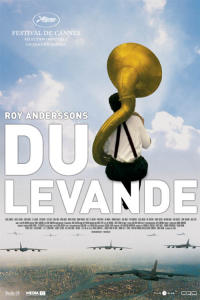
DU LEVANDE (YOU THE LIVING)
Sweden, 2007, 94 minutes, Colour.
Directed by Roy Andersson.
You the Living is the second feature film from commercials maker Roy Andersson, a multi-award-winning designer of commercials which are avant-garde and surreal?
He has something of a pessimistic view of human nature – although, despite the apocalyptic nature of the ending, he is hopeful that humans can actually improve in their relationships with one another.
The film was made in his own studios using amateurs for the characters. Many of them have the touch of the grotesque, certainly of the bizarre. He also uses a somewhat washed-out colour scheme.
The film is a series of vignettes, in an unnamed city, beginning with a dream of bombers flying overhead and ending with this reality.
The film is tragic as well as comic, moves quickly from one vignette to another (with some characters reappearing, the woman who complained that nobody loved her, the barkeeper for whom the last orders are always being called, the young girl infatuated with the rock star).
The film has been described as metaphysical and comical.
1.The work of Roy Andersson, feature films? Commercials? His surreal style?
2.The unnamed city, the city locations, apartments, hotels, the streets? The weather? Reality and unreality? The dreams? The bombers? The musical score?
3.The writing, comic, offbeat? The dramatisations? The fixed camera and its effect? The camera trick with the bride and groom, the people outside their window, moving? Emerging from a train?
4.The vignettes:
The man waking from the nightmare, approaching bombers.
The middle-aged woman, her appearance, her depression, complaining to her boyfriend, no-one liking her, the dog, her saying she would be along later, her appearance in the bar, the same talk.
Anna, the rock guitarist in the bar, her approaching him.
The schoolteacher who comes and complains to her class because her husband has insulted her.
The husband, the customers buying carpet, there not being enough, the argument with his wife.
The man whose nightmare has him trying to pull the tablecloth from under the family dinner, his failure, the women complaining about his breaking the crockery, the court case, his being sentenced to death, the electric chair scene.
The professor, at the banquet, speaking on the phone, his son wanting money.
The businessman, vanity in the restaurant, the stealing of his wallet by the man sitting by.
The psychiatrist, complaining, unable to make people happy.
The tuba player, his savings, the sexual encounter with his wife.
The Arab barber, the racist customer, the violence.
The customer, the meeting, the man dropping dead, the widow pleading for forgiveness.
Anna, with the guitarist, her dream of married bliss, in the train carriage.
The people at the bus stop, not making room during the rain.
The people looking up at the sky, the approaching bombers over the city.